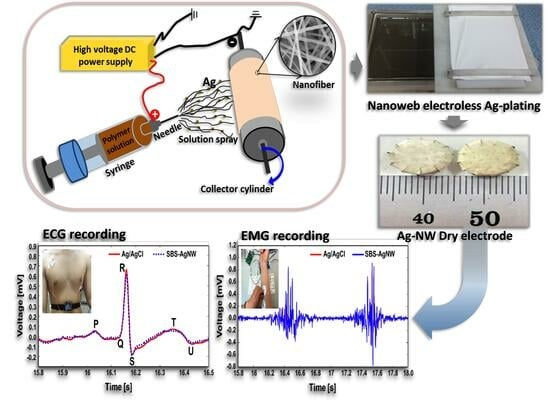Electrospun Rubber Nanofiber Web-Based Dry Electrodes for Biopotential Monitoring
Abstract
:1. Introduction
2. Materials and Methods
2.1. Preparation of Nanofiber Web, Electroless Silver Plating, and Fabrication of Dry Electrode
2.2. Electrode Properties on Agar Phantom
2.3. Biopotential Recording on a Human Subject
2.4. EIT System and Imaging Experiments
3. Results and Discussion
3.1. Morphology of Electrospun Nanoweb before and after Silver Plating
3.2. Electrode Properties of AgNW Dry Electrodes on Agar Phantom
3.3. Biopotential Recording
3.4. EIT Test with Multiple Electrodes
3.5. Electrode Stability Test
4. Conclusions
5. Patents
Supplementary Materials
Author Contributions
Funding
Institutional Review Board Statement
Informed Consent Statement
Data Availability Statement
Conflicts of Interest
References
- Webster, J.G.; Clark, W.J. Medical Instrumentation: Application and Design, 3rd ed.; John Wiley & Sons Inc.: Hoboken, NJ, USA, 2008. [Google Scholar]
- Berbari, E.J. Principles of Electrocardiography. In The Biomedical Engineering Handbook, 2nd ed.; Bronzino, J.D., Ed.; CRC Press: Boca Raton, FL, USA, 2000; Volume 1. [Google Scholar]
- Grimnes, S.; Martinsen, O.G. Bioimpedance and Bioelectricity Basics, 2nd ed.; Academic Press: Cambridge, MA, USA, 2008. [Google Scholar]
- Oh, T.I.; Yoon, S.; Kim, T.E.; Wi, H.; Kim, K.J.; Woo, E.J.; Sadleir, R.J. Nanofiber Web Textile Dry Electrodes for Long-Term Biopotential Recording. IEEE Trans. Biomed. Circuits Syst. 2013, 7, 204–211. [Google Scholar] [PubMed]
- Chi, Y.M.; Jung, T.P.; Cauwenberghs, G. Dry-Contact and Noncontact Biopotential Electrodes: Methodological Review. IEEE Rev. Biomed. Eng. 2010, 3, 106–119. [Google Scholar] [CrossRef]
- Chen, Y.-H.; De Beeck, M.O.; Vanderheyden, L.; Carrette, E.; Mihajlović, V.; Vanstreels, K.; Grundlehner, B.; Gadeyne, S.; Boon, P.; Van Hoof, C. Soft, Comfortable Polymer Dry Electrodes for High-Quality ECG and EEG Recording. Sensors 2014, 14, 23758–23780. [Google Scholar] [CrossRef] [PubMed]
- Lin, C.-T.; Liao, L.-D.; Liu, Y.-H.; Wang, I.J.; Lin, B.-S.; Chang, J.-Y. Novel Dry Polymer Foam Electrodes for Long-Term EEG Measurement. IEEE Trans. Biomed. Eng. 2011, 58, 1200–1207. [Google Scholar] [PubMed]
- Nicolas-Alonso, L.F.; Gomez-Gil, J. Brain Computer Interfaces, A Review. Sensors 2012, 12, 1211–1279. [Google Scholar] [CrossRef]
- Oh, T.I.; Kim, T.E.; Yoon, S.; Kim, K.J.; Woo, E.J.; Sadleir, R.J. Flexible Electrode Belt for EIT Using Nanofiber Web Dry Electrodes. Physiol. Meas. 2012, 33, 1603–1616. [Google Scholar] [CrossRef]
- Myers, A.C.; Huang, H.; Zhu, Y. Wearable Silver Nanowire Dry Electrodes for Electrophysiological Sensing. RSC Adv. 2015, 5, 11627–11632. [Google Scholar] [CrossRef]
- Yoo, J.; Yan, L.; Lee, S.; Kim, H.; Yoo, H.J. A Wearable ECG Acquisition System with Compact Planar-Fashionable Circuit Board-Based Shirt. IEEE Trans. Inf. Technol. Biomed. 2009, 13, 897–902. [Google Scholar] [CrossRef]
- Lin, C.T.; Chang, K.C.; Lin, C.L.; Chiang, C.C.; Lu, S.W.; Chang, S.S.; Lin, B.S.; Liang, H.Y.; Chen, R.J.; Lee, Y.T.; et al. An Intelligent Telecardiology System Using a Wearable and Wireless ECG to Detect Atrial Fibrillation. IEEE Trans. Inf. Technol. Biomed. 2010, 14, 726–733. [Google Scholar]
- Merino, M.; Rivera, O.; Gomez, I.; Molina, A.; Dorronzoro, E. A Method of EOG Signal Processing to Detect the Direction of Eye Movements. In Proceedings of the 2010 First International Conference on Sensor Device Technologies and Applications, Venice, Italy, 18–25 July 2010; pp. 100–105. [Google Scholar]
- Usakli, A.B.; Gurkan, S.; Aloise, F.; Vecchiato, G.; Babiloni, F. On the Use of Electrooculogram for Efficient Human Computer Interfaces. Comput. Intell. Neurosci. 2010, 2010, 135629. [Google Scholar] [CrossRef]
- Yathunanthan, S.; Chandrasena, L.U.R.; Umakanthan, A.; Vasuki, V.; Munasinghe, S.R. Controlling a Wheelchair by Use of EOG Signal. In Proceedings of the 2008 4th International Conference on Information and Automation for Sustainability, Colombo, Sri Lanka, 12–14 December 2008; pp. 283–288. [Google Scholar]
- Hinrichs, H.; Scholz, M.; Baum, A.K.; Kam, J.W.; Knight, R.T.; Heinze, H.J. Comparison Between a Wireless Dry Electrode EEG System with a Conventional Wired Wet Electrode EEG System for Clinical Applications. Sci. Rep. 2020, 10, 5218. [Google Scholar] [CrossRef] [PubMed]
- Frerichs, I.; Amato, M.B.; Van Kaam, A.H.; Tingay, D.G.; Zhao, Z.; Grychtol, B.; TREND Study Group. Chest Electrical Impedance Tomography Examination, Data Analysis, Terminology, Clinical Use and Recommendations: Consensus Statement of the Translational EIT Development Study Group. Thorax 2017, 72, 83–93. [Google Scholar] [CrossRef] [PubMed]
- Webster, J.G. Medical Instrumentation: Application and Design; Wiley: New York, NY, USA, 1998. [Google Scholar]
- Meziane, N.; Webster, J.G.; Attari, M.; Nimunkar, A.J. Dry Electrodes for Electrocardiography. Physiol. Meas. 2013, 34, R47–R69. [Google Scholar] [CrossRef] [PubMed]
- Xu, P.J.; Zhang, H.; Tao, X.M. Textile-Structured Electrodes for Electrocardiogram. Text. Prog. 2008, 40, 183–213. [Google Scholar] [CrossRef]
- Gruetzmann, A.; Hansen, S.; Müller, J. Novel Dry Electrodes for ECG Monitoring. Physiol. Meas. 2007, 28, 1375–1390. [Google Scholar] [CrossRef]
- Kisannagar, R.R.; Jha, P.; Navalkar, A.; Maji, S.K.; Gupta, D. Fabrication of Silver Nanowire/Polydimethylsiloxane Dry Electrodes by a Vacuum Filtration Method for Electrophysiological Signal Monitoring. ACS Omega 2020, 5, 10260–10265. [Google Scholar] [CrossRef]
- Alizadeh-Meghrazi, M.; Ying, B.; Schlums, A.; Lam, E.; Eskandarian, L.; Abbas, F.; Sidhu, G.; Mahnam, A.; Moineau, B.; Popovic, M.R. Evaluation of dry textile electrodes for long-term electrocardiographic monitoring. BioMed. Eng. OnLine 2021, 20, 68. [Google Scholar] [CrossRef]
- Voica, S.-C.; Drăgulinescu, A.; Drăgulinescu, A.-M. Dry-electrode based ECG monitoring device with electrodes reliability test capabilities. In Proceedings of the 2020 IEEE 8th Electronics System-Integration Technology Conference (ESTC), Tønsberg, Norway, 15–18 September 2020; pp. 1–6. [Google Scholar]
- Lopez-Gordo, M.A.; Sanchez-Morillo, D.; Valle, F.P. Dry EEG Electrodes. Sensors 2014, 14, 12847–12870. [Google Scholar] [CrossRef]
- Lee, J.S.; Heo, J.; Lee, W.K.; Lim, Y.G.; Kim, Y.H.; Park, K.S. Flexible Capacitive Electrodes for Minimizing Motion Artifacts in Ambulatory Electrocardiograms. Sensors 2014, 14, 14732–14743. [Google Scholar] [CrossRef]
- Ruffini, G.; Dunne, S.; Fuentemilla, L.; Grau, C.; Farres, E.; Marco-Pallares, J.; Watts, P.C.P.; Silva, S.R.P. First Human Trials of a Dry Electrophysiology Sensor Using a Carbon Nanotube Array Interface. Sens. Actuator A Phys. 2008, 144, 275–279. [Google Scholar] [CrossRef]
- Hsu, L.-S.; Tung, S.-W.; Kuo, C.-H.; Yang, Y.-J. Developing Barbed Microtip-Based Electrode Arrays for Biopotential Measurement. Sensors 2014, 14, 12370–12386. [Google Scholar] [CrossRef] [PubMed]
- Ng, W.C.; Seet, H.L.; Lee, K.S.; Ning, N.; Tai, W.X.; Sutedja, M.; Fuh, J.Y.H.; Li, X.P. Micro-Spike EEG Electrode and the Vacuum-Casting Technology for Mass Production. J. Mater. Process. Technol. 2009, 209, 4434–4438. [Google Scholar] [CrossRef]
- Salvo, P.; Raedt, R.; Carrette, E.; Schaubroeck, D.; Vanfleteren, J.; Cardon, L. A 3D Printed Dry Electrode for ECG/EEG Recording. Sens. Actuator A Phys. 2012, 174, 96–102. [Google Scholar] [CrossRef]
- Shyamkumar, P.; Rai, P.; Oh, S.; Ramasamy, M.; Harbaugh, R.E.; Varadan, V. Wearable Wireless Cardiovascular Monitoring Using Textile-Based Nanosensor and Nanomaterial Systems. Electronics 2014, 3, 504–520. [Google Scholar] [CrossRef]
- Kim, D.H.; Lu, N.; Ma, R.; Kim, Y.S.; Kim, R.H.; Wang, S.; Wu, J.; Won, S.M.; Tao, H.; Islam, A.; et al. Epidermal Electronics. Science 2011, 333, 838–843. [Google Scholar] [CrossRef]
- Mota, A.R.; Duarte, L.; Rodrigues, D.; Martins, A.C.; Machado, A.V.; Vaz, F.; Fiedler, P.; Haueisen, J.; Nóbrega, J.M.; Fonseca, C. Development of a Quasi-Dry Electrode for EEG Recording. Sens. Actuator A Phys. 2013, 199, 310–317. [Google Scholar] [CrossRef]
- Fu, Y.; Zhao, J.; Dong, Y.; Wang, X. Dry Electrodes for Human Bioelectrical Signal Monitoring. Sensors 2020, 20, 3651. [Google Scholar] [CrossRef]
- Gan, Y.; Vauche, R.; Pons, J.-F.; Rahajandraibe, W. Dry Electrode Materials for Electrocardiographic Monitoring. In Proceedings of the 2018 25th IEEE International Conference on Electronics, Circuits and Systems (ICECS), Bordeaux, France, 9–12 September 2018; pp. 645–646. [Google Scholar]
- Searle, A.; Kirkup, L. A Direct Comparison of Wet, Dry and Insulating Bioelectric Recording Electrodes. Physiol. Meas. 2000, 21, 271–283. [Google Scholar] [CrossRef]
- Hoffmann, K.P.; Ruff, R. Flexible Dry Surface Electrodes for ECG Long-Term Monitoring. In Proceedings of the 2007 29th Annual International Conference of the IEEE Engineering in Medicine and Biology Society, Lyon, France, 22–26 August 2007; pp. 5739–5742. [Google Scholar]
- Ferri, J.; Llinares, R.; Segarra, I.; Cebrián, A.; Garcia-Breijo, E.; Millet, J. A new method for manufacturing dry electrodes on textiles. Validation for wearable ECG monitoring. Electrochem. Commun. 2022, 136, 107244. [Google Scholar] [CrossRef]
- Lobodzinski, S.S.; Laks, M.M. Comfortable Textile-Based Electrocardiogram Systems for Very Long-Term Monitoring. Cardiol. J. 2008, 15, 477–480. [Google Scholar]
- Jin, L.; Kim, K.J.; Song, E.H.; Ahn, Y.J.; Jeong, Y.J.; Oh, T.I.; Woo, E.J. Highly Precise Nanofiber Web-Based Dry Electrodes for Vital Signal Monitoring. RSC Adv. 2016, 6, 40045–40057. [Google Scholar] [CrossRef]
- Lenko, D.; Schlögl, S.; Kramer, R.; Kern, W.; Schaller, R.; Holzner, A. Contributions to the Characterization of Chlorinated Polyisoprene Surfaces. Macromol. Symp. 2012, 311, 9–17. [Google Scholar] [CrossRef]
- Mandal, D.; Kim, K.J.; Lee, J.S. Simple Synthesis of Palladium Nanoparticles, β-Phase Formation, and the Control of Chain and Dipole Orientations in Palladium-Doped Poly(vinylidene fluoride) Thin Films. Langmuir 2012, 28, 10310–10317. [Google Scholar] [CrossRef] [PubMed]
- Oh, T.I.; Wi, H.; Kim, D.Y.; Yoo, P.J.; Woo, E.J. A Fully Parallel Multi-Frequency EIT System with Flexible Electrode Configuration: KHU Mark2. Physiol. Meas. 2011, 32, 835. [Google Scholar] [CrossRef]
- Rosell, J.; Colominas, J.; Riu, P.; Pallas-Areny, R.; Webster, J.G. Skin Impedance from 1 Hz to 1 MHz. IEEE Trans. Biomed. Eng. 1988, 35, 649–651. [Google Scholar] [CrossRef] [PubMed]
- Berson, A.S.; Pipberger, H.V. Skin-Electrode Impedance Problems in Electrocardiography. Am. Heart J. 1968, 76, 514–525. [Google Scholar] [CrossRef]
- McAdams, E.T.; Jossinet, J.; Lackermeier, A.; Risacher, F. Factors Affecting Electrode-Gel-Skin Interface Impedance in Electrical Impedance Tomography. Med. Biol. Eng. Comput. 1996, 34, 397–408. [Google Scholar] [CrossRef]
- Taji, B.; Shirmohammadi, S.; Groza, V.; Bolic, M. An ECG Monitoring System Using Conductive Fabric. In Proceedings of the 2013 IEEE International Symposium on Medical Measurements and Applications (MeMeA), Gatineau, QC, Canada, 4–5 May 2013; pp. 309–314. [Google Scholar]
- Taji, B.; Shirmohammadi, S.; Groza, V.; Batkin, I. Impact of Skin–Electrode Interface on Electrocardiogram Measurements Using Conductive Textile Electrodes. IEEE Trans. Instrum. Meas. 2014, 63, 1412–1422. [Google Scholar] [CrossRef]
- Laferriere, P.; Lemaire, E.D.; Chan, A.D.C. Surface Electromyographic Signals Using Dry Electrodes. IEEE Trans. Instrum. Meas. 2011, 60, 3259–3268. [Google Scholar] [CrossRef]
- Barrett, A.; Donnelly, E.; Olaighin, G. Tibialis Anterior EMG Activation Pattern Changes with Walking Speed During Over Ground and Treadmill Walking. In Proceedings of the 2007 29th Annual International Conference of the IEEE Engineering in Medicine and Biology Society, Lyon, France, 22–26 August 2007; pp. 4883–4886. [Google Scholar]
- Frerichs, I. Electrical Impedance Tomography (EIT) in Applications Related to Lung and Ventilation: A Review of Experimental and Clinical Activities. Physiol. Meas. 2000, 21, R1–R21. [Google Scholar] [CrossRef]
- Grychtol, B.; Elke, G.; Meybohm, P.; Weiler, N.; Frerichs, I.; Adler, A. Functional Validation and Comparison Framework for EIT Lung Imaging. PLoS ONE 2014, 9, e103045. [Google Scholar] [CrossRef] [PubMed]
- Constantin, J.M.; Perbet, S.; Delmas, J.; Futier, E. Electrical Impedance Tomography: So Close to Touching the Holy Grail. Crit. Care 2014, 18, 164. [Google Scholar] [CrossRef]
- McAdams, E.T.; Jossinet, J. The importance of electrode-skin impedance in high resolution electrocardiography. Automedica 1991, 13, 187–208. [Google Scholar]
- Oh, T.I.; Koo, W.; Lee, K.H.; Kim, S.M.; Lee, J.; Kim, S.W.; Seo, J.K.; Woo, E.J. Validation of a multi-frequency electrical impedance tomography (mfEIT) system KHU Mark1: Impedance spectroscopy and time-difference imaging. Phys. Meas. 2008, 29, 295–307. [Google Scholar] [CrossRef] [PubMed]
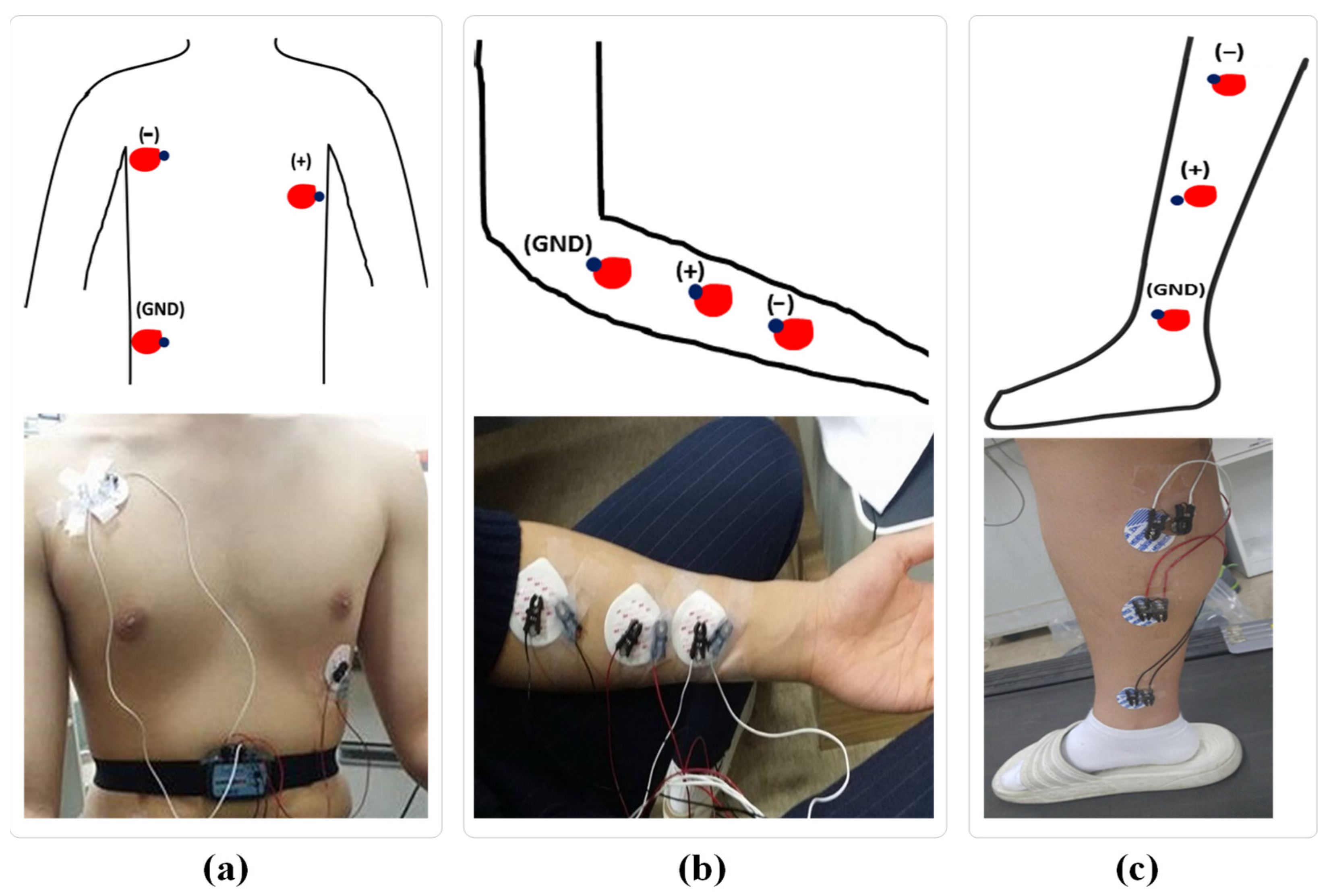


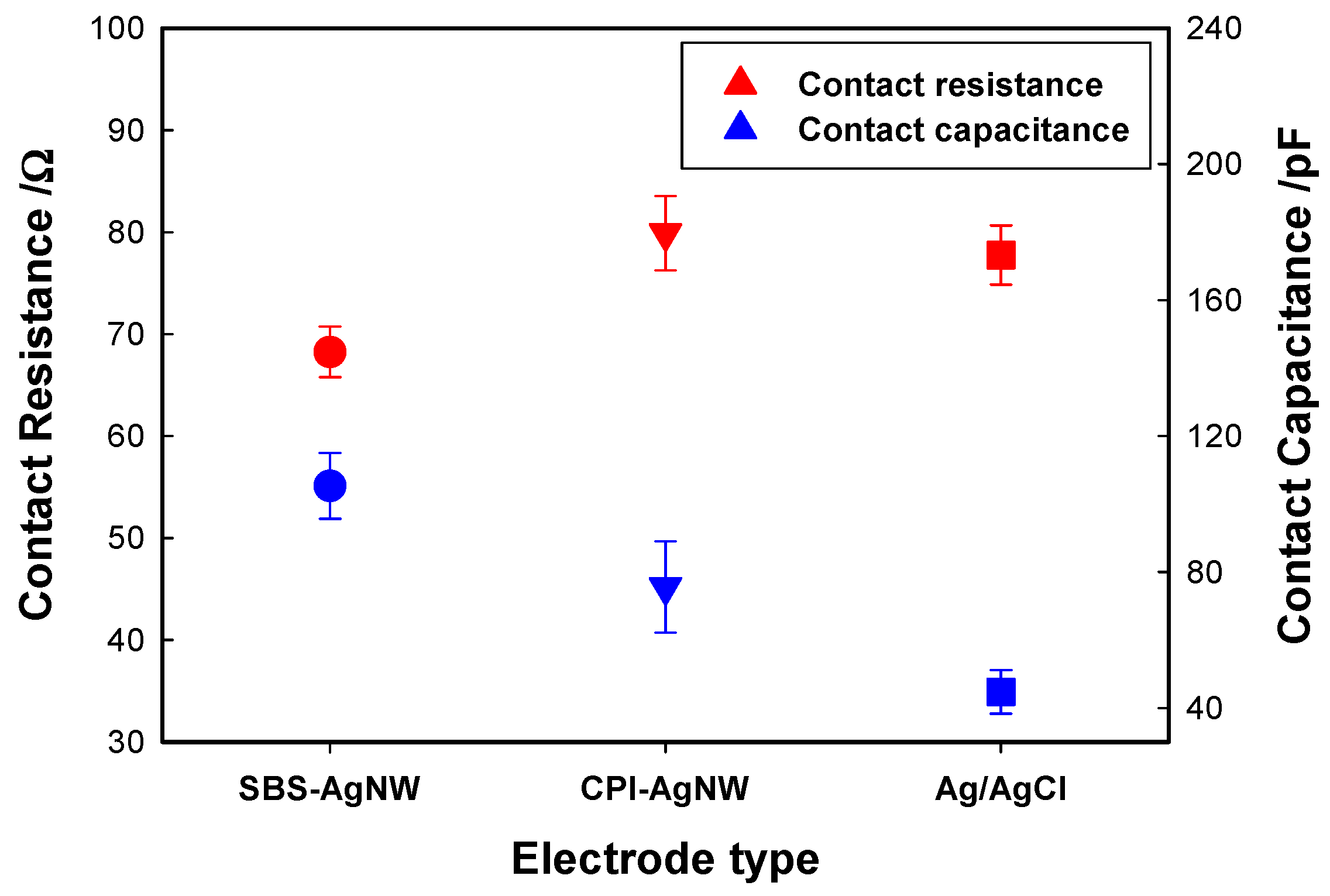
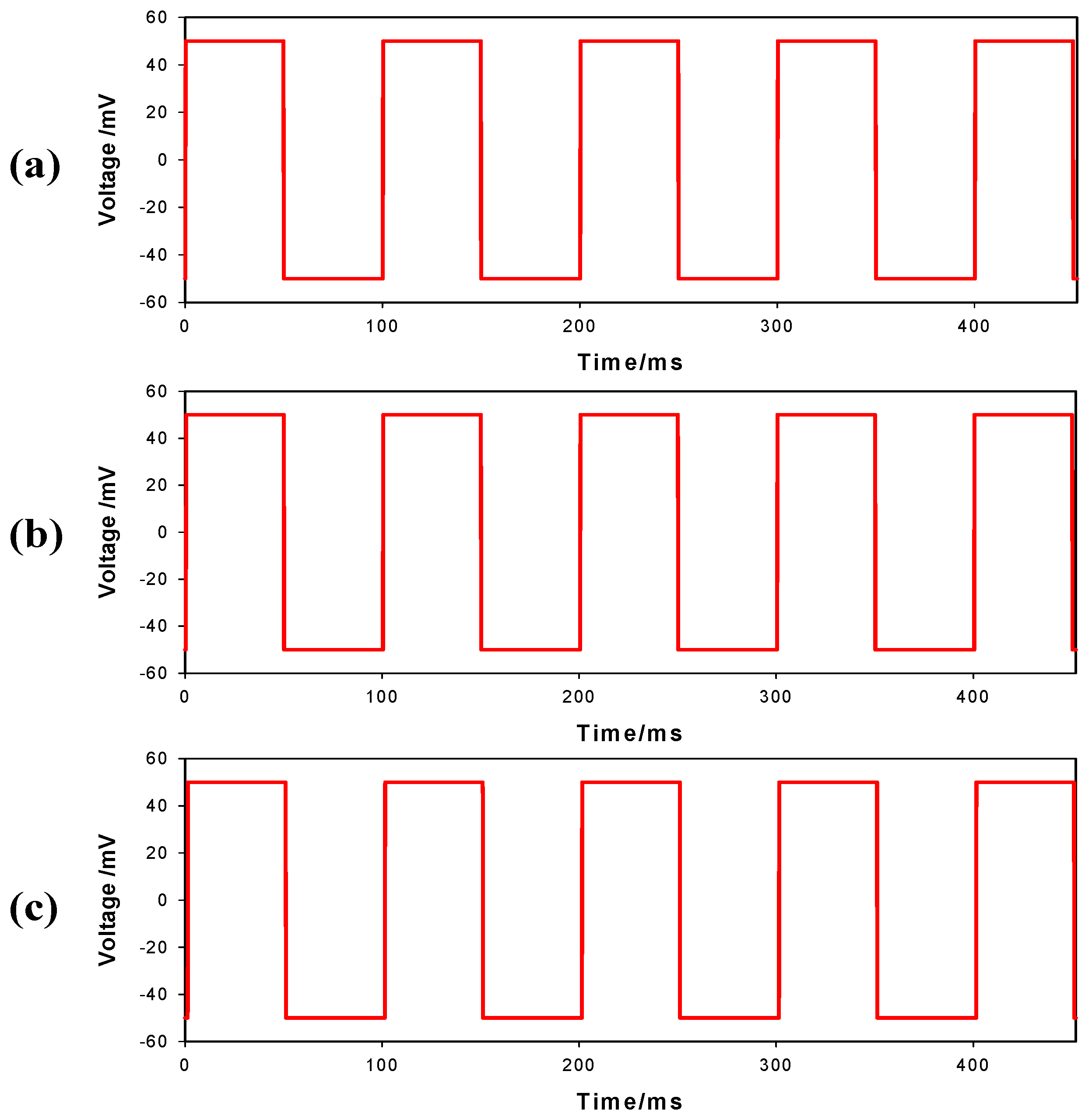
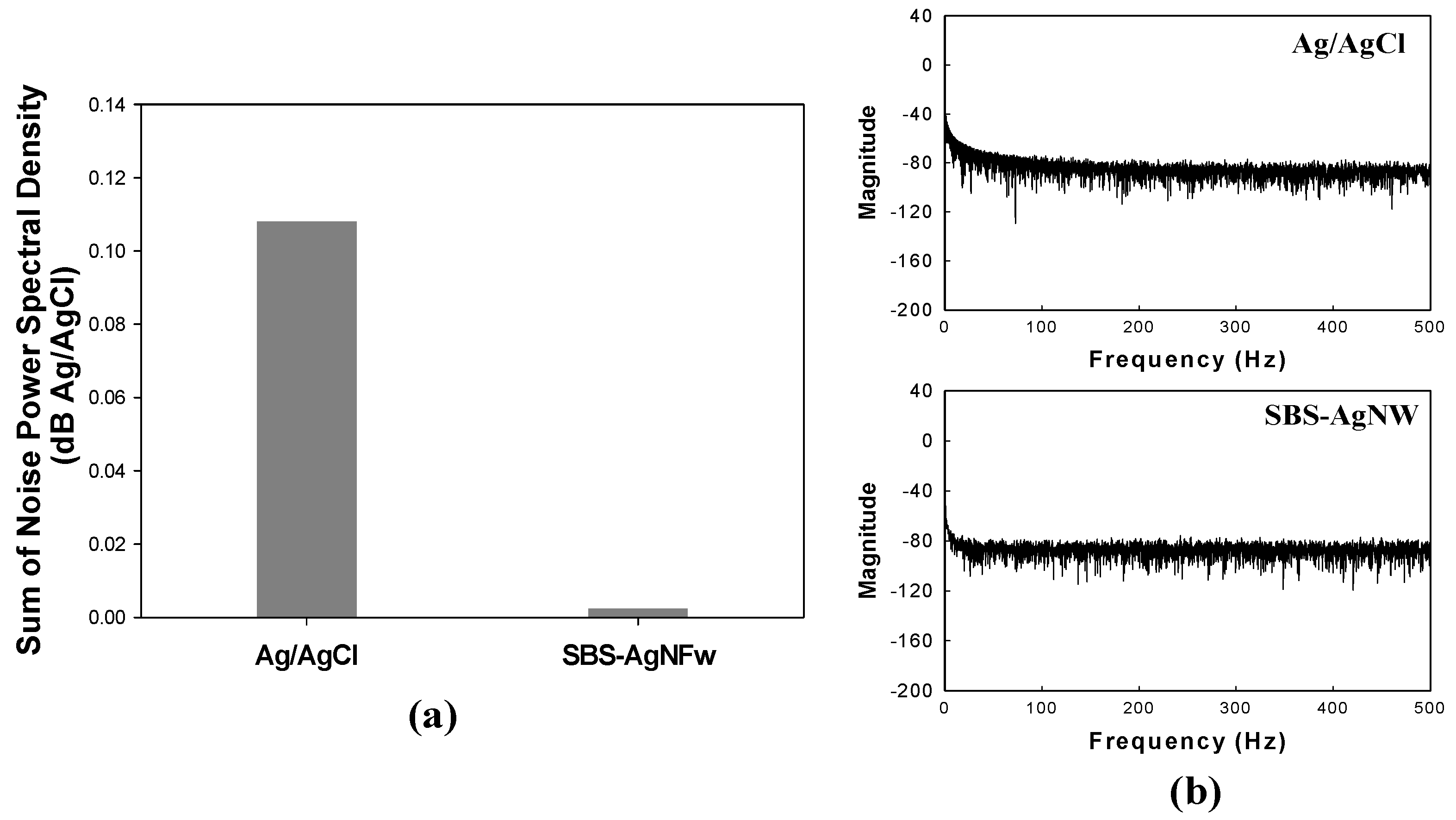
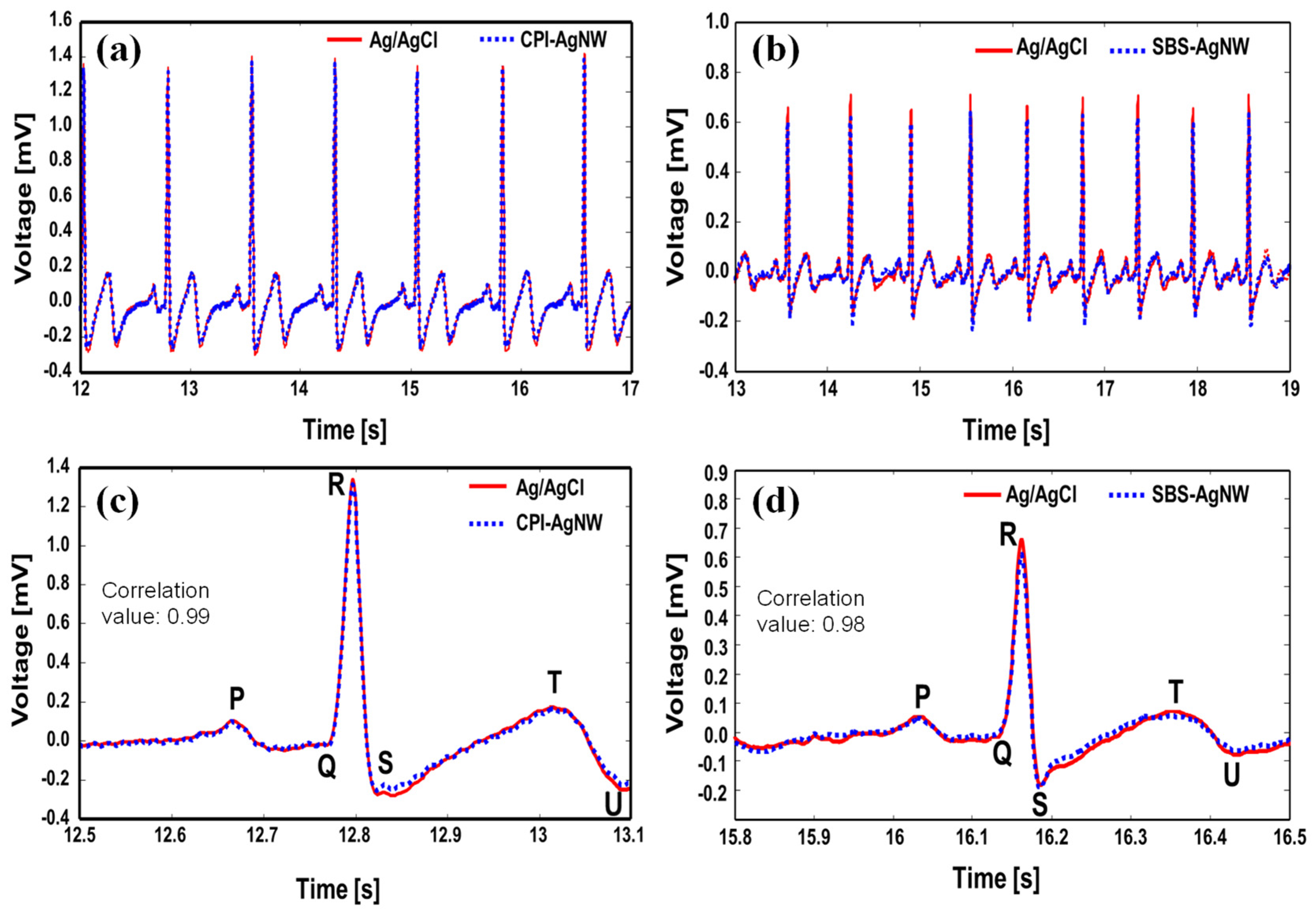


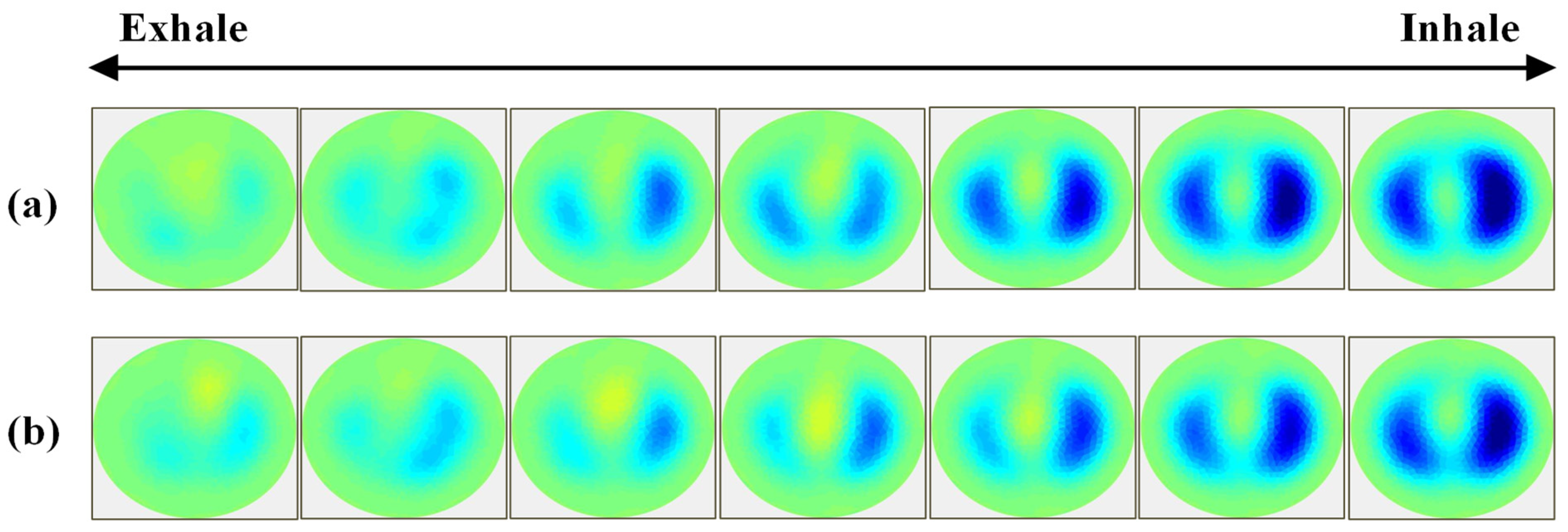
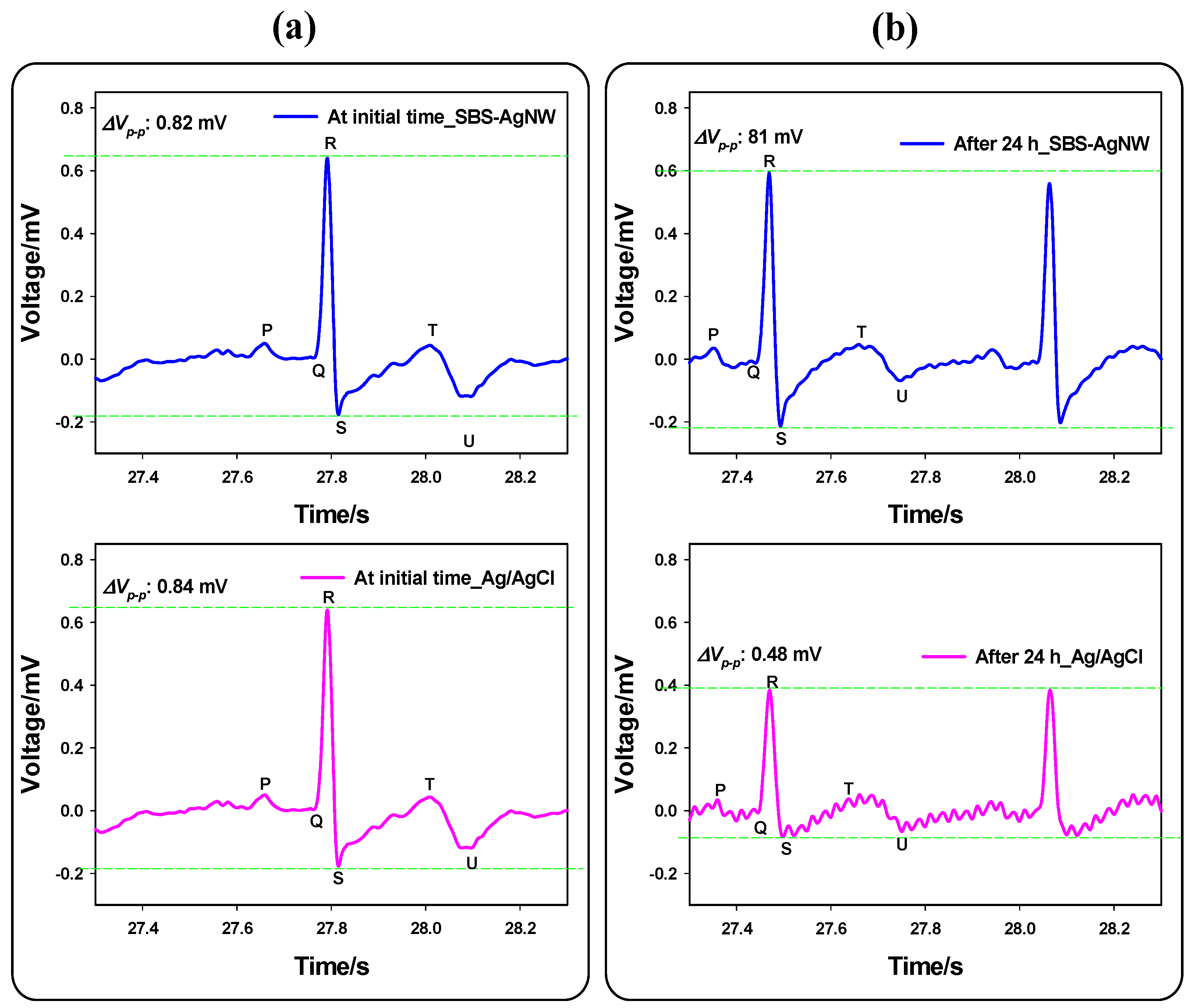
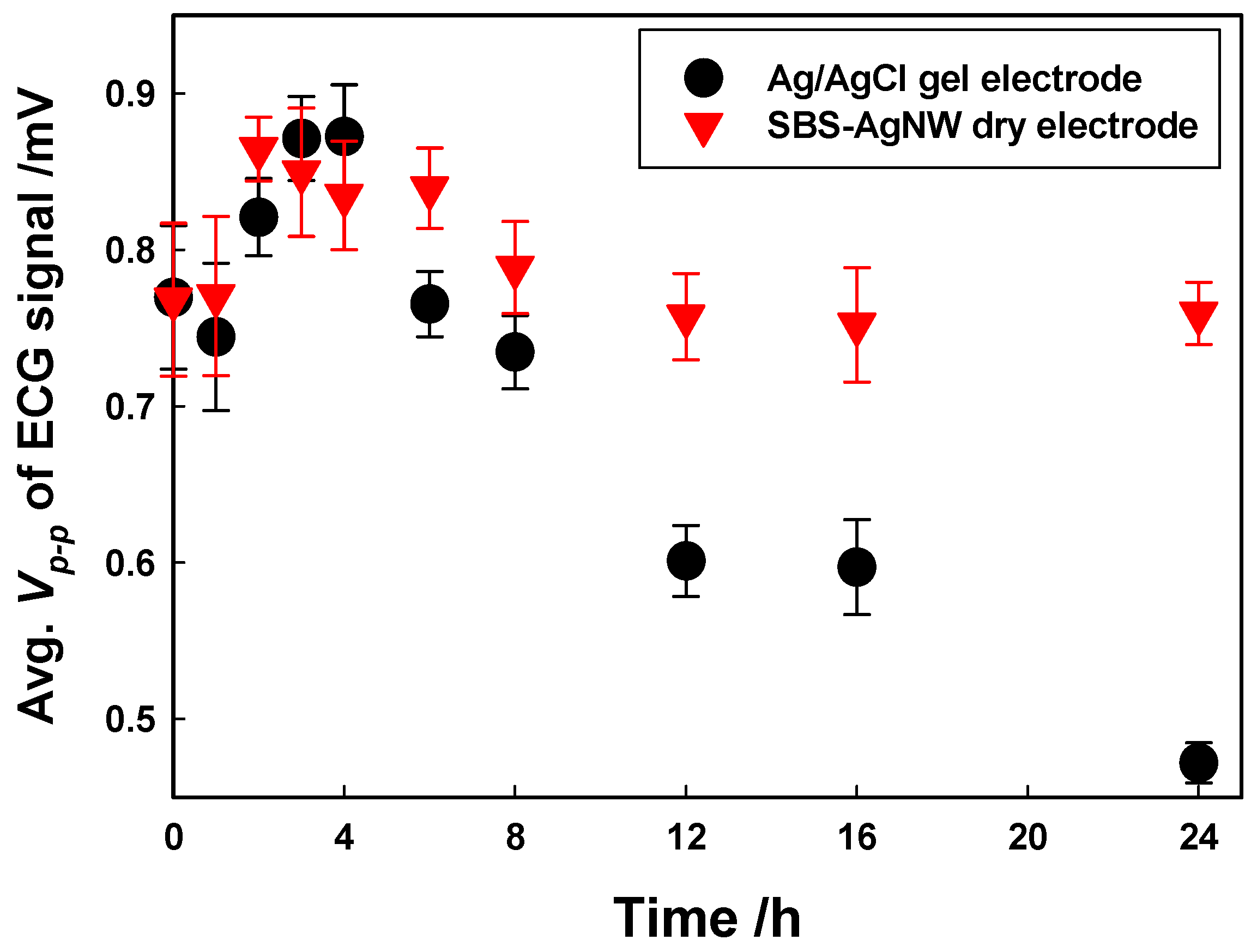
Disclaimer/Publisher’s Note: The statements, opinions and data contained in all publications are solely those of the individual author(s) and contributor(s) and not of MDPI and/or the editor(s). MDPI and/or the editor(s) disclaim responsibility for any injury to people or property resulting from any ideas, methods, instructions or products referred to in the content. |
© 2023 by the authors. Licensee MDPI, Basel, Switzerland. This article is an open access article distributed under the terms and conditions of the Creative Commons Attribution (CC BY) license (https://creativecommons.org/licenses/by/4.0/).
Share and Cite
Reza, M.S.; Jin, L.; Jeong, Y.J.; Oh, T.I.; Kim, H.; Kim, K.J. Electrospun Rubber Nanofiber Web-Based Dry Electrodes for Biopotential Monitoring. Sensors 2023, 23, 7377. https://doi.org/10.3390/s23177377
Reza MS, Jin L, Jeong YJ, Oh TI, Kim H, Kim KJ. Electrospun Rubber Nanofiber Web-Based Dry Electrodes for Biopotential Monitoring. Sensors. 2023; 23(17):7377. https://doi.org/10.3390/s23177377
Chicago/Turabian StyleReza, Mohammad Shamim, Lu Jin, You Jeong Jeong, Tong In Oh, Hongdoo Kim, and Kap Jin Kim. 2023. "Electrospun Rubber Nanofiber Web-Based Dry Electrodes for Biopotential Monitoring" Sensors 23, no. 17: 7377. https://doi.org/10.3390/s23177377





